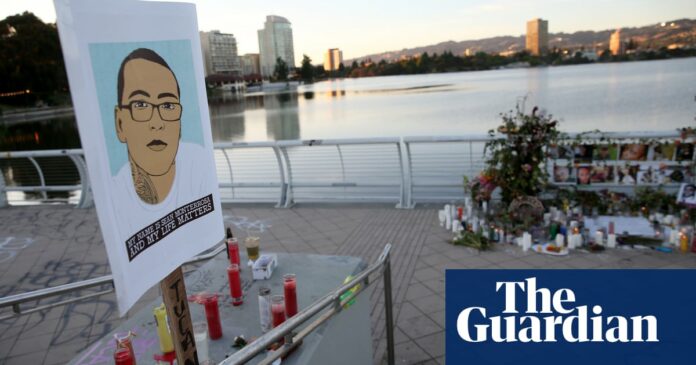Body-camera footage of the deadly police shooting of Sean Monterrosa has raised new questions about why a Vallejo officer fired a round of bullets from inside his vehicle at the unarmed 22-year-old.
The 2 June killing in the small city north of San Francisco took place outside a Walgreens amid national protests over the police killing of George Floyd. Vallejo officers were responding to a call about looting after midnight when one officer, identified by local reporters as Detective Jarrett Tonn, drove up and fired through the windshield of his unmarked car. After the shooting, the city’s police chief said Monterrosa was on his knees with his hands raised, and that he had a hammer in his pocket.
The killing of the beloved San Francisco native sparked outrage across the country, and the body-camera footage released Wednesday has raised more questions than it answers.
The footage does not show Monterrosa before he was killed or his position while he was shot, but it captures the moment of the shooting from inside the police car, and the aftermath. The footage, released more than a month after the killing, shows:
-
The officer fired the shots from inside his car before he had fully stopped his vehicle.
-
In the seconds after the shooting, two officers questioned whether Monterrosa was armed, one saying: “What did he point at us?” and the other responding: “I don’t know.”
-
After the shooting, an officer suggested that Monterrosa was fleeing, saying: “He ran, he ran!”
-
An officer had multiple outbursts after the killing, shouting: “This is not what I fucking needed today!” and “Stupid!”
The footage makes clear there was “no de-escalation” and “no justification” for lethal force, said John Burris, the family’s attorney.
“He was never given a chance. He was just shot,” Burris told the Guardian after he watched the video with Monterrosa’s sisters and father, before police publicly released it. “There was no consideration for this person’s life.”
The footage was released after weeks of pressure from attorneys, lawmakers and advocates. The killing has renewed scrutiny on Vallejo, a Bay Area city where police are known for killing and brutalizing citizens at a high rate without consequence. Vallejo police have refused to confirm the name of the officer who fired the fatal shots, but Open Vallejo and the Bay Area News Group have identified the shooter as Tonn.
Tonn has been involved in four shootings in five years and is one of 14 Vallejo policemen whom residents call the “Fatal 14” – officers who have repeatedly shot and killed civilians.
At one point in the minutes after the shooting of Monterrosa, the body-camera footage captured another officer trying to calm Tonn, saying, “You’ll be all right. Take some deep breaths. You’ve been through this before.”
Once the cameras were turned on, the officers started remarking to each other that they thought Monterrosa was armed with a gun. Burris said the conversation suggested some were doubting the justification for lethal force.
Burris said he was especially disturbed to learn that the officer did not turn on his camera before the shooting, and noted that police officials have continued to shift their narrative of what happened. Days after the shooting, Shawny Williams, the Vallejo police chief, told reporters that Monterrosa was kneeling with his hands raised and that the officer mistakenly thought he had a gun, and later discovered it was a hammer in his pocket.
But the police union, which represents the officer, later claimed Monterrosa was “crouched into a tactical shooting position” and “grabbed an object” that appeared to be the butt of handgun, saying: “The officer used deadly force as a last resort because he had no other reasonable option to prevent getting shot.”
“The Vallejo police union concocted a different scenario once they knew there was no tape,” Burris said. “This is what happens with police departments and in Vallejo.”
Melissa Nold, another attorney for the family, noted that Vallejo officers who kill often return to work weeks after the shooting. She said she didn’t know the status of Detective Tonn, but said it would not be safe for him to return to the streets given the killing of Monterrosa and his long record of shootings: “I hope they don’t ever put him back on patrol.”
A Vallejo police spokesperson, Brittany Jackson, declined to answer questions about Tonn. Asked about the claims that the department had changed its story, Jackson said the chief had “issued clarifying statements” after comments from his original press conference were “misconstrued”.
Before Monterrosa, Vallejo police killed Willie McCoy, a 20-year-old who had been sleeping in his car when six officers fired 55 bullets in 3.5 seconds. One of those officers had previously killed an unarmed man who was fleeing on his bike. Another officer was promoted after he killed three men in a five-month period.






